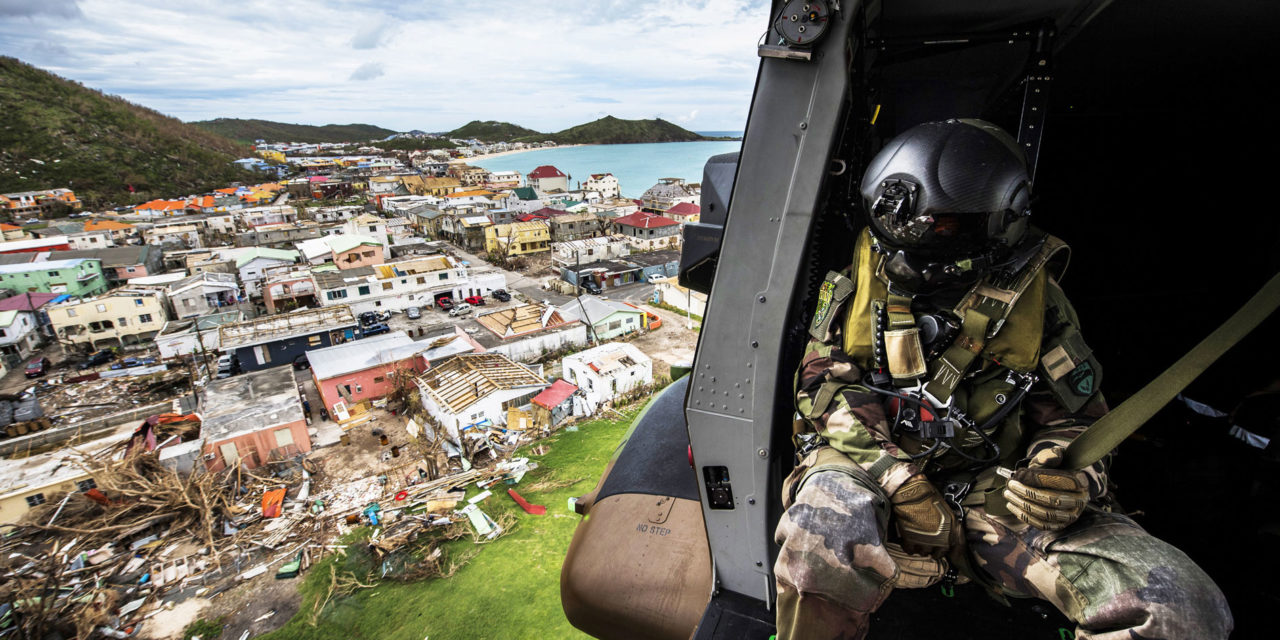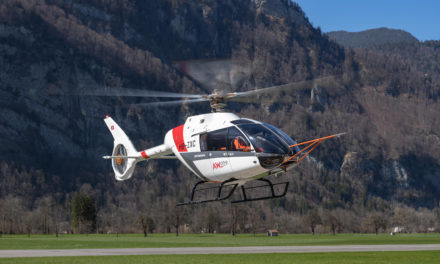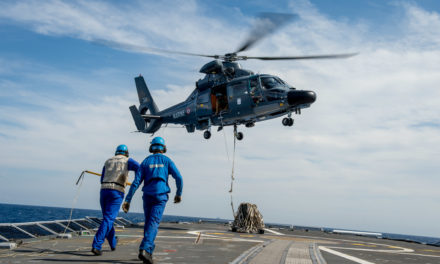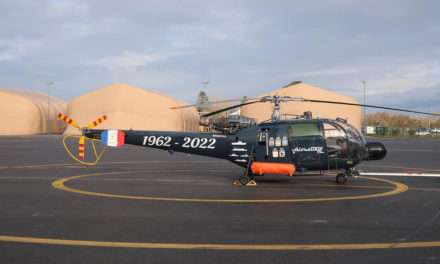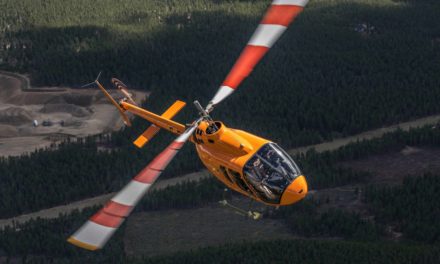The French Army’s Light Aviation division (ALAT) sent its NH90 Caimans to help the populations affected by Hurricane Irma. The aircraft proved their worth and made their advantages over the Puma, which they are gradually replacing, quite clear.
In the wee hours between September 5 and 6, 2017, the season’s second major hurricane, Irma, barreled through several Caribbean islands, including Saint Barthélemy and Saint Martin. Winds reaching top speeds of nearly 300 kph wreaked havoc, destroying thousands of homes in just seconds. In the wake of the devastating meteorological phenomenon, authorities tallied more than 130 deaths in the Caribbean and southern United States, including 11 on the French overseas territories of Saint Barthélemy and Saint Martin.
Less than 48 hours after Irma battered Saint Martin, the 1st Combat Helicopter Regiment (RHC), stationed at Phalsbourg, was put on pre-alert. “We were asked to prepare to send out several helicopters very quickly,” explains Lieutenant Colonel Cyril C., who heads up the regiment’s Reconnaissance and Attack Helicopters Battalion (BHRA). “At first, we planned to send four Gazelles, two NH90 Caimans and two Pumas. The next morning, we were put on 24-hour alert, but the size of the detachment had been reduced to two Caimans and two Pumas. Given the role the helicopters were to play in the field, the general staff decided utility helicopters were best suited for the task.” The Caimans were assigned from the 1st RHC and the Pumas from the 3rd RHC (stationed in Etain). Lieutenant Colonel C. was named mission chief of the detachment.
Things get underway
On Friday September 8 at 2 pm, the first Puma took off from Etain headed for Orléans. That night, it was loaded onto one of the French Airforce’s A400Ms to make its way to the Caribbean. In addition to the helicopter, the hold of the strategic transport aircraft also carried its crew, a team of mechanics, and a set of spare parts—enough equipment to last 10 days on its own as it awaited the arrival of the three other helicopters, which were set to make the trip by boat.
As the first Puma was flying west, its blades dismantled and packed away, Phalsbourg began organizing to supply the two Caimans required for the mission. The task was far from easy because of operational overlap: “We were right in the middle of preparing for the Bois Belleau exercise,” explained Lieutenant Colonel C. “As part of Bois Belleau, we were supposed to load two Caimans and two Gazelles onto a helicopter carrier at the end of November for a four-month mission! It was going to be the first open-sea deployment of ALAT’s Caimans. We had just one month to prepare for that and get the pack-up kits (PUK) ready. And ten, all of a sudden, disaster struck, and we had to do the same thing in just 48 hours to help the victims of Irma in the Caribbean.”
Two aircraft were ready and standing by with enough flight time ahead of them to get started: 300 hours for the first one, 150 for the second. As for the PUK, we included everything possible. “The mission was originally scheduled to last two months, but we know from experience that this kind of mission uses up a lot of flight hours, so we set off with maximum availability, and made sure we had all the spare parts we could need,” underscored Lieutenant Colonel C.
A convoy of trucks left Phalsbourg on Sunday September 10, headed for Toulon, where the Navy’s helicopter carrier had already managed to load the supplies and equipment provided by the French armed forces, police, and a host of different aid organizations. The next morning, the NH90s flew south to the Cannet des Maures air base, where they met up with the 3rd RHC’s Puma. The three aircraft were loaded onto the ship once the deck had been cleared of all of the recently loaded materials. By the end of the day, the Caimans and Puma had settled into their floating base for the next several weeks. A Puma deployed by the French Airforce also joined them. The Tonnerre finally weighed anchor in the early morning of Thursday September 13.
A busy crossing
“We sent to experienced crews with our Caimans,” emphasized Lieutenant Colonel C. “We needed pilots certified for deck-landing who weren’t on alert for Operation Barkhane in Mali or involved in the Bois Belleau mission. It was complicated!”
Each crew is made up of a pilot; a captain, who is also a pilot; an onboard mechanic; and a loadmaster. The eight crew members were also accompanied by a small tactical team comprising the mission chief, a logistics officer, an operations officer, a transmissions team, a doctor and a nurse for Medevac missions, and everything needed for maintenance. “When we board a helicopter carrier, we provide some of the personnel needed for the aircraft to take off and land on deck,” explained Lieutenant Colonel C. In other words, in addition to 15 ground mechanics, we also provide air traffic controllers, firefighters, blade folders, etc.” In all, 69 people make up the ALAT detachment on the helicopter carrier.
It took 10 days to reach Saint Martin from Toulon. The ALAT detachment used the time to train its crews and maintain qualifications, night and day. They also studied different scenarios and the different possible ways to handle the upcoming landing, so they can get on with their missions as soon as possible. Over the 10 days they also maintain contact with the first Puma on site. After unloading from the A400M, the aircraft was declared operational on September 12, just in time to support French President Emmanuel Macron’s visit of the island and to participate in reconnaissance missions necessary to begin more involved missions.
A step up
Twenty-four hours before its expected arrival in Saint Martin, when it is still 150 nautical miles from the island, the helicopter carrier launched its three aircraft: the two Caimans and the Puma headed for the island, to drop off the beach reconnaissance teams with their material and to enter into contact with the French soldiers already on the ground. The helicopters then returned to the ship, which continued its course toward the island. In the end, it dropped anchor in a bay located two nautical miles from the shore. The time had come to launch their operations, under the aegis of the island’s civil authorities and of the general military staff in the Caribbean The Tonnerre turns out to be doubly useful: the ship not only transported the helicopters to the island, it also served as a floating base, a totally independent operations HQ untouched by the hurricane’s devastation. That said, the ALAT detachment nevertheless permanently disembarked part of its forces, including one Puma sent to Martinique, where Hurricane Maria had just struck—the helicopter carrier arrived in the Caribbean just three days after this second hurricane.
The two Caimans also made several comfortable round trips to Martinique, thanks to their speed and endurance. At a cruising speed of 145 knots, the aircraft were able to make the trip in just two hours, thanks to efficient navigational equipment. Night or day, the round trip took just four hours, with significant endurance remaining after landing. But the Caimans were mostly used on Saint Martin, where their transport and hoisting abilities were particularly appreciated.
“The Puma can lift 1.4 metric tons in a sling for 35 minutes of flight time, while the Caiman can lift twice that with an endurance of two hours!” highlights Lieutenant Colonel C. “The progress made from one generation to the next is incredible, and having both aircraft working on the same operation, often side by side, made that perfectly obvious! The Caiman’s power reserves mean it’s no big deal of a crew is surprised with a load considerably heavier than planned.”
Some of the ALAT Caimans’ greatest feats include hoisting a customs speedboat out of the water near Happy Bay. Once above the surface, the boat weighed in at 3 metric tons in the sling! The Caiman was at ease, though close to its limits. Another one for the record books was the removal of debris from a relay antenna felled by the hurricane on the island’s tallest peak. The bent beams were gathered into bundles weighing several tons each, hoisted one at a time in a sling. Caught off guard by one excessively heavy bundle (most likely over 4 metric tons), the crew had to disengage the hook and drop the load. The bundle was then separated into two smaller groups and operations were able to continue without further incident.
Between convoy and logistical missions, the Caimans also helped to restore the island’s power grid by replacing downed electrical posts. A new profession for ALAT! The 11-ton helicopter lent itself gracefully to the precision work. “The missions were very technical and incredibly interesting for our teams,” reported Lieutenant Colonel C. “In just over a month of operation, the two Caimans racked up about 100 flight hours, both day and night, sometimes with NVGs, and all while ensuring constant availability.”
A regiment giving its all
The 1st RHC was the first regiment of ALAT to take delivery of Caimans, at the end of 2013. At end 2017, the delivery schedule hasn’t quite been completed, with the regiment having received 13 of the 21 expected helicopters. Its fleet should be complete by the end of 2018. In the meantime, the regiment has said goodbye to all its old Pumas and has been involved in a number of operations with its new aircraft. Four Caimans are permanently based in Gao as part of operation Barkhane, with the personnel on a rotating roster in the theater, where they also fly three Tiger HADs. As of early 2018, two Caimans are out at sea as part of Mission Bois Belleau, and six others are with the manufacturer for maintenance.
By Frédéric Lert
@photos by Sirpa Marine

